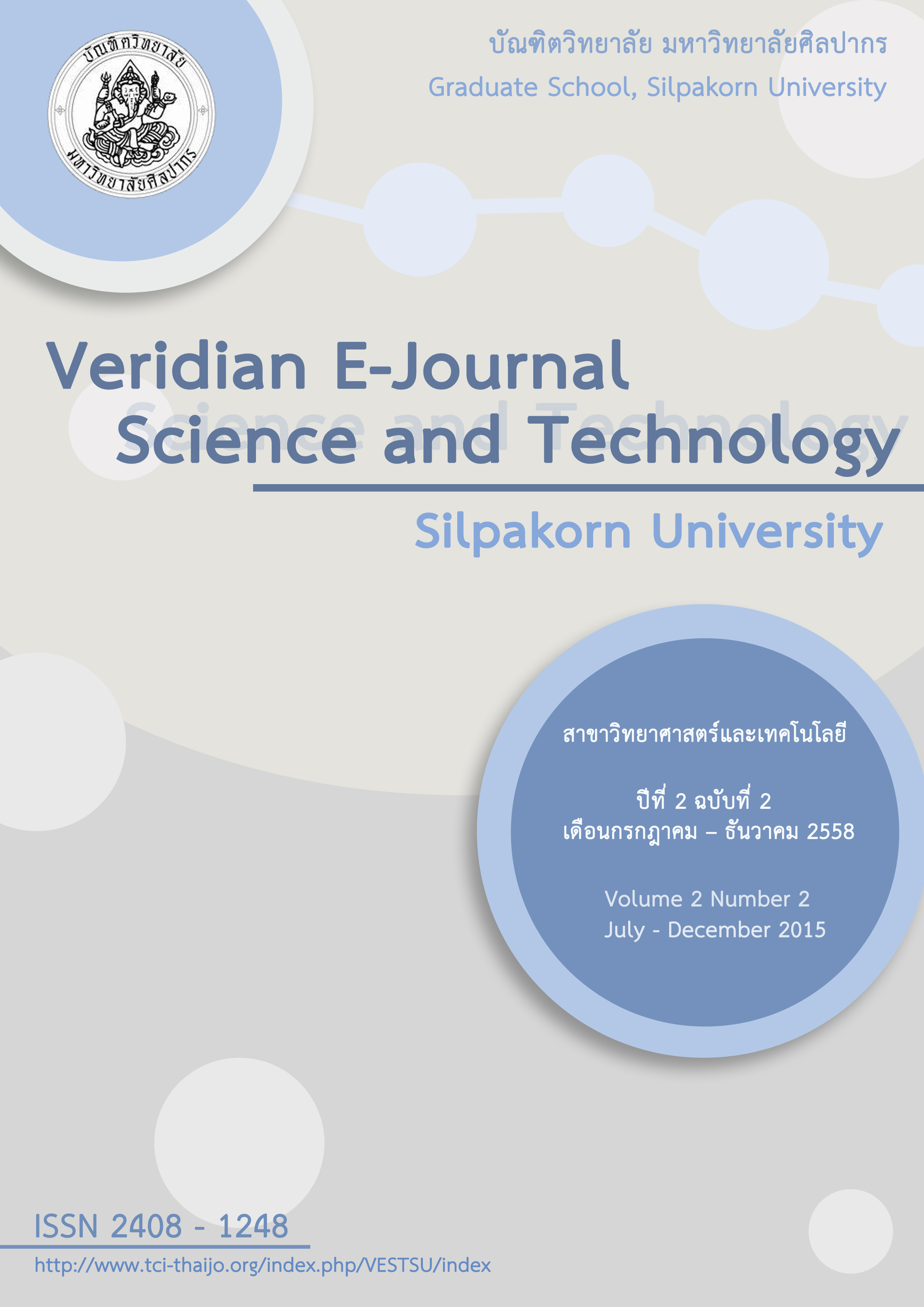การใช้เทคนิคการทำเหมืองข้อมูลเพื่อพยากรณ์ผลการเรียนของนักเรียน โรงเรียนสาธิตแห่งมหาวิทยาลัยเกษตรศาสตร์ วิทยาเขตกำแพงแสน ศูนย์วิจัยและพัฒนาการศึกษา
Main Article Content
Abstract
บทคัดย่อ
การวิจัยครั้งนี้มีวัตถุประสงค์เพื่อพัฒนาคลังข้อมูล และสร้างตัวแบบพยากรณ์ผลการเรียนของนักเรียนโรงเรียนสาธิตแห่งมหาวิทยาลัยเกษตรศาสตร์ วิทยาเขตกำแพงแสน ศูนย์วิจัยและพัฒนาการศึกษา โดยใช้ข้อมูลนักเรียนระดับมัธยมศึกษาระหว่างปีการศึกษา 2548 – 2556 เพื่อพัฒนาคลังข้อมูลโดยใช้โครงสร้างแบบสโนว์เฟลก สกีมาและนำเสนอรายงาน จากนั้นใช้ข้อมูลนักเรียนระดับมัธยมศึกษาปีที่ 4 ระหว่าง ปีการศึกษา 2553 – 2556 จำนวน 525 ระเบียน ประกอบด้วย 16 คุณลักษณะ มาสร้างตัวแบบพยากรณ์ผลการเรียนโดย ใช้ชุดข้อมูล 2 แบบ คือ ข้อมูลแบบไม่จัดกลุ่ม (Original Data) และข้อมูลแบบจัดกลุ่ม (Cluster Data)จากนั้นนำไปผ่านกระบวนการคัดเลือกคุณลักษณะ (Feature Selection) ซึ่งใช้วิธี Correlation-based Feature Selection (CFS) และวิธี Information Gain (IG) แล้วใช้เทคนิคเหมืองข้อมูลแบบโครงข่ายประสาทเทียมแบบมัลติเลเยอร์เพอร์เซ็ปตรอน (MLP) ซัพพอร์ตเวกเตอร์แมชชีน (SVM) และต้นไม้ตัดสินใจ (Decision Tree) มาสร้างตัวแบบพยากรณ์และเปรียบเทียบตัวแบบ ด้วยการทดสอบประสิทธิภาพแบบ 10-fold Cross Validation
ผลการวิจัยพบว่า คลังข้อมูลนักเรียนระดับมัธยมศึกษาที่ใช้งานโดย ผู้บริหาร หัวหน้ากลุ่มสาระการเรียนรู้ และอาจารย์ประจำชั้นมีความพึงพอใจการใช้งานคลังข้อมูลอยู่ในระดับดี และในการทำเหมืองข้อมูลพยากรณ์ พบว่า ชุดข้อมูลแบบไม่จัดกลุ่มนำมาคัดเลือกคุณลักษณะด้วยวิธี Correlation-based Feature Selection (CFS) ร่วมกับเทคนิคโครงข่ายประสาทเทียมแบบมัลติเลเยอร์เพอร์เซ็ปตรอน ให้ ค่าความถูกต้องสูงที่สุดที่ร้อยละ 94.48 และมีค่ารากที่สองของความคลาดเคลื่อนน้อยที่สุดที่ 0.1880 เหมาะสมสำหรับการสร้างระบบพยากรณ์ผลการเรียนของนักเรียน
Abstract
The purpose of this research were to develop the data warehouse from the structure of Snowflake Schema and to construct the “Prediction Model” of high school students achievement from the data during academic year 2005-2013 of Kasetsart University Laboratory school, Kamphaeng Saen Campus Educational Research and Development Center. The sample consisted of 525 records of Matayom Suksa 4 students’ achievement including 16 features of attributes to construct the tradition Model with 2 sets of data types : original data and data cluster. Then the features were selected by Correlation – based Feature Selection (CFS) and Information Gain (IG). After that the “Prediction Model” was constructed by data mining techniques like Neural Networks, Multi-layer Perceptron (MLP), Support Vector Machine (SVM) and Decision Tree Model. Finally, the model was compared by the Performance Test with a 10-fold Cross Validation.
The results showed that the administrators, the department leaders, and the advisors were satisfied with the high school students’ data warehouse at a good level and, by using data mining techniques, the set of original data, for feature selection with correlation based feature selection (CFS) combining with a Multi-layer Perceptron Concept, provided the highest accuracy at 94.48 percent and the second root of the discrepancy was the least at 0.1880 which was suitable to construct the students Prediction system.

